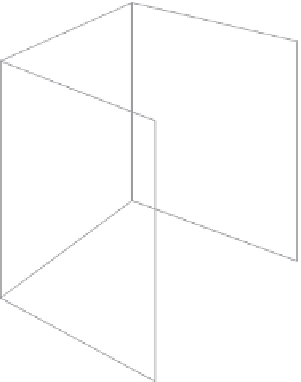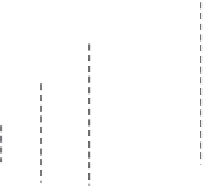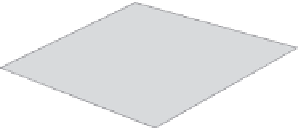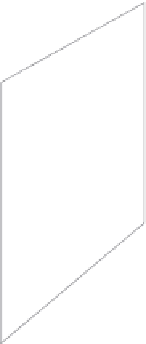Geoscience Reference
In-Depth Information
Surface current
M
a
s
s
t
r
a
n
s
p
o
r
t
Figure 8.2 The Ekman spiral in the Northern Hemisphere.
the direction of the current spirals with increasing depth. This phenomenon
is called the
Ekman spiral
. For a westerly surface wind, the Ekman spiral is
clockwise in the Northern Hemisphere and counterclockwise in the Southern
Hemisphere, with the current speed decreasing with depth as the frictional ac-
celeration that originates at the surface weakens (
Figure 8.2)
.
We can calculate current velocities using the horizontal momentum equa-
tions (Eqs. 6.56 and 6.57), simplified to capture the essential physics of the
problem. Since mixed-layer currents are observed to occur under steady-state
conditions and in the absence of advection, let
2
u
==− −=
v
v
v
vu vv
$
d
$
d
0.
(8.1)
2
t
2
t
Wind-driven surface currents are also generated in the absence of pressure gra-
dient forces within the ocean mixed layer, so the pressure gradient force can
also be assumed to be zero, and the equations of motion reduce simply to
x
=+
(8.2)
0
fv
F
E
F
and
y
=− + ,
(8.3)
0
fu
F
E
F
where the subscript E denotes the Ekman velocity components.
We now develop an expression for friction that represents the force of the
wind on surface waters and the force of adjacent layers of water on each other.
Define horizontal
stress
,
v
t t
as the frictional force per unit area ex-
erted on a parcel of water. A parcel at the surface experiences wind stress on its
upper surface [
()
x
y
τ
=+
τ
i
τ
j
,
x
t > 0 when the surface wind is westerly] and frictional drag
from the water below on its lower surface [
()
z
x
t < 0], as diagrammed in
Figure
8.3.
The geometry is the same for parcels below that are frictionally accelerated
by the water layer above and decelerated by frictional drag from below. Let
z



























